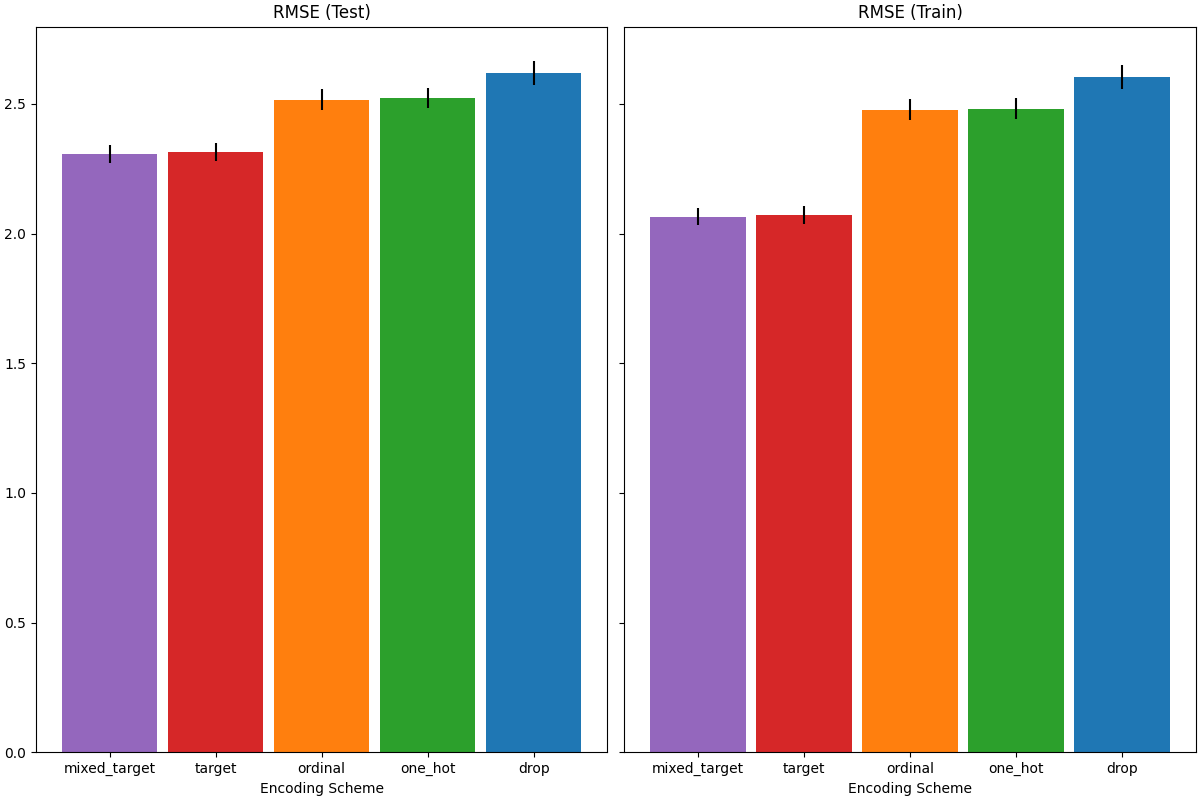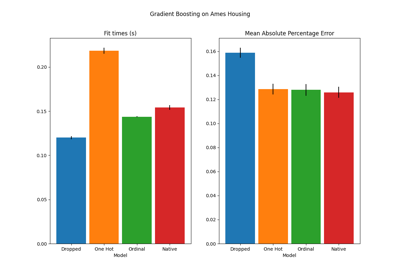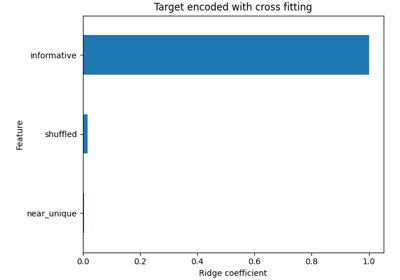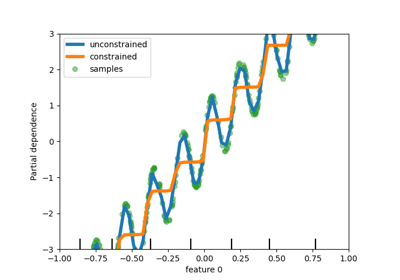备注
Go to the end 下载完整的示例代码。或者通过浏览器中的MysterLite或Binder运行此示例
比较目标编码器与其他编码器#
的 TargetEncoder 使用目标的值来编码每个类别特征。在本示例中,我们将比较处理类别特征的三种不同方法: TargetEncoder , OrdinalEncoder , OneHotEncoder 并删除该类别。
备注
fit(X, y).transform(X) 不等于 fit_transform(X, y) 因为交叉匹配方案用于 fit_transform 用于编码。看到 User Guide .有关详细信息
# Authors: The scikit-learn developers
# SPDX-License-Identifier: BSD-3-Clause
从OpenML加载数据#
首先,我们加载葡萄酒评论数据集,其中目标是评论者给出的分数:
from sklearn.datasets import fetch_openml
wine_reviews = fetch_openml(data_id=42074, as_frame=True)
df = wine_reviews.frame
df.head()
对于本示例,我们在数据中使用以下数字和类别特征子集。目标是从80到100的连续值:
numerical_features = ["price"]
categorical_features = [
"country",
"province",
"region_1",
"region_2",
"variety",
"winery",
]
target_name = "points"
X = df[numerical_features + categorical_features]
y = df[target_name]
_ = y.hist()

使用不同编码器训练和评估管道#
在本节中,我们将评估管道 HistGradientBoostingRegressor 具有不同的编码策略。首先,我们列出将用于预处理类别特征的编码器:
from sklearn.compose import ColumnTransformer
from sklearn.preprocessing import OneHotEncoder, OrdinalEncoder, TargetEncoder
categorical_preprocessors = [
("drop", "drop"),
("ordinal", OrdinalEncoder(handle_unknown="use_encoded_value", unknown_value=-1)),
(
"one_hot",
OneHotEncoder(handle_unknown="ignore", max_categories=20, sparse_output=False),
),
("target", TargetEncoder(target_type="continuous")),
]
接下来,我们使用交叉验证来评估模型并记录结果:
from sklearn.ensemble import HistGradientBoostingRegressor
from sklearn.model_selection import cross_validate
from sklearn.pipeline import make_pipeline
n_cv_folds = 3
max_iter = 20
results = []
def evaluate_model_and_store(name, pipe):
result = cross_validate(
pipe,
X,
y,
scoring="neg_root_mean_squared_error",
cv=n_cv_folds,
return_train_score=True,
)
rmse_test_score = -result["test_score"]
rmse_train_score = -result["train_score"]
results.append(
{
"preprocessor": name,
"rmse_test_mean": rmse_test_score.mean(),
"rmse_test_std": rmse_train_score.std(),
"rmse_train_mean": rmse_train_score.mean(),
"rmse_train_std": rmse_train_score.std(),
}
)
for name, categorical_preprocessor in categorical_preprocessors:
preprocessor = ColumnTransformer(
[
("numerical", "passthrough", numerical_features),
("categorical", categorical_preprocessor, categorical_features),
]
)
pipe = make_pipeline(
preprocessor, HistGradientBoostingRegressor(random_state=0, max_iter=max_iter)
)
evaluate_model_and_store(name, pipe)
原生分类特征支持#
在本节中,我们构建和评估一个使用本地分类特征支持的管道 HistGradientBoostingRegressor ,仅支持多达255个独特类别。在我们的数据集中,大多数类别特征都有超过255个独特类别:
n_unique_categories = df[categorical_features].nunique().sort_values(ascending=False)
n_unique_categories
winery 14810
region_1 1236
variety 632
province 455
country 48
region_2 18
dtype: int64
为了解决上述限制,我们将类别特征分为低基数特征和高基数特征。高基数特征将被目标编码,低基数特征将在梯度增强中使用本地分类特征。
high_cardinality_features = n_unique_categories[n_unique_categories > 255].index
low_cardinality_features = n_unique_categories[n_unique_categories <= 255].index
mixed_encoded_preprocessor = ColumnTransformer(
[
("numerical", "passthrough", numerical_features),
(
"high_cardinality",
TargetEncoder(target_type="continuous"),
high_cardinality_features,
),
(
"low_cardinality",
OrdinalEncoder(handle_unknown="use_encoded_value", unknown_value=-1),
low_cardinality_features,
),
],
verbose_feature_names_out=False,
)
# The output of the of the preprocessor must be set to pandas so the
# gradient boosting model can detect the low cardinality features.
mixed_encoded_preprocessor.set_output(transform="pandas")
mixed_pipe = make_pipeline(
mixed_encoded_preprocessor,
HistGradientBoostingRegressor(
random_state=0, max_iter=max_iter, categorical_features=low_cardinality_features
),
)
mixed_pipe
最后,我们使用交叉验证来评估管道并记录结果:
evaluate_model_and_store("mixed_target", mixed_pipe)
绘制结果#
在本节中,我们通过绘制测试和训练分数来显示结果:
import matplotlib.pyplot as plt
import pandas as pd
results_df = (
pd.DataFrame(results).set_index("preprocessor").sort_values("rmse_test_mean")
)
fig, (ax1, ax2) = plt.subplots(
1, 2, figsize=(12, 8), sharey=True, constrained_layout=True
)
xticks = range(len(results_df))
name_to_color = dict(
zip((r["preprocessor"] for r in results), ["C0", "C1", "C2", "C3", "C4"])
)
for subset, ax in zip(["test", "train"], [ax1, ax2]):
mean, std = f"rmse_{subset}_mean", f"rmse_{subset}_std"
data = results_df[[mean, std]].sort_values(mean)
ax.bar(
x=xticks,
height=data[mean],
yerr=data[std],
width=0.9,
color=[name_to_color[name] for name in data.index],
)
ax.set(
title=f"RMSE ({subset.title()})",
xlabel="Encoding Scheme",
xticks=xticks,
xticklabels=data.index,
)

当评估测试集的预测性能时,放弃类别的表现最差,而目标编码器的表现最好。这可以解释如下:
删除类别特征会导致管道的表达力减弱且不适合;
由于基数高并且为了减少训练时间,一热编码方案使用
max_categories=20这可以防止特征扩展过多,从而导致配合不足。如果我们没有设置
max_categories=20,当特征数量随着偶然与目标相关的罕见类别出现而爆炸时(仅在训练集中),一次性编码方案可能会使管道过度匹配;序数编码将任意顺序强加给特征,这些特征然后由
HistGradientBoostingRegressor.由于该模型将数字特征分组为每个特征256个箱,因此许多不相关的类别可以分组在一起,因此整个管道可能不适合;当使用目标编码器时,会发生相同的装仓,但由于编码值是按照与目标变量的边际关联进行统计排序的,因此
HistGradientBoostingRegressor这是有意义的,并导致了良好的结果:平滑目标编码和分箱的组合作为一个很好的正则化策略,防止过拟合,同时不会限制管道的表现力太多。
Total running time of the script: (0分18.624秒)
相关实例
Gallery generated by Sphinx-Gallery <https://sphinx-gallery.github.io> _




